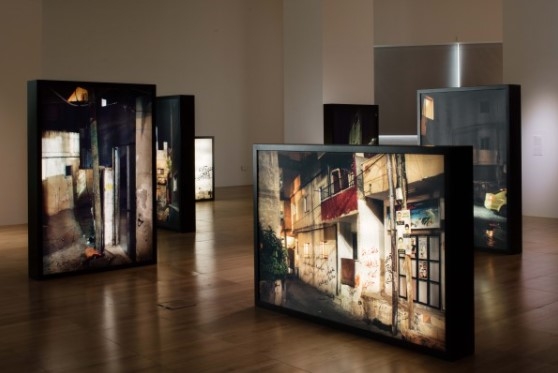The exhibition is based in Palestine and a close collaboration between Charles Esche and the artists / architects Sandi Hilal and Alessandro Petti. In the work Refugee Heritage, they speculate about what would happen if the Dheisheh refugee camp in Palestine was designated as a UNESCO World Heritage Site, with the same status as, for example, the pyramids of Giza, Birka or the Taj Mahal. In the form of light boxes and photo albums, the installation refers to the camp and its connection to the villages that a large number of people were forced to leave in 1948. Dheisheh, formed in 1949, can be understood as a permanent, temporary society in a stateless nation that exists both within and in opposition to the UN regulations. By proposing the Dheisheh community as something worth preserving and nurturing, the conditions for how a world cultural heritage can emerge for a moment change. Can exile lead us to a different understanding of the need for nation states? What should be preserved once the occupation of Palestine becomes a historical memory?
Based on this central question, the exhibition moves towards a number of works that present concrete proposals to highlight new cultural heritage or shift, twist and turn existing perceptions of how the past works in our time and in the future. Several works deal with the historical colonial exploitation and the inequality and devastation caused by global capitalism. These include Jonas Staal’s documentaries from Rojava, which depict the process of establishing democratic confederalism in the Kurdish region of northern Syria, and Taus Makhacheva’s balancing act where museum paintings are moved by a rope dancer between two mountain peaks in the Caucasus, and an installation with paintings on the theme of land exploitation in Brazil. and Namibia by Otobong Nkanga. Furthermore, Renzo Martens & CATPC are shown: s depiction of a cultural heritage conflict between a group of artists from the Democratic Republic of Congo and an American museum. The exhibition will also contain works by Katarina Pirak Sikku, FCNN and Jeannette Ehlers & LaVaughn Belle and others who in various ways relate to Scandinavia’s colonial past and future.
A large part of the works come from the Van Abbemuseum in Eindhoven, which has processed its colonial history together with artists in a number of exhibitions, seminars and publications in recent years. In connection with the exhibition, a rich program is conducted in dialogue with the art historian Mårten Snickare, who teaches postcolonial studies at Stockholm University and who has researched the colonial trophies of the Swedish great power era and speculated about the potential future of museum objects. The series “Another look at…” is a number of visits to places and collections with the aim of discussing how the perception of cultural heritage has changed over the centuries under the influence of colonialism, post- and neocolonialism to the point where we are today.
Together with the curators Tawanda Appiah and Mmabatho Thobejane, two events are arranged that deal with how sound has been perceived and used as cultural heritage by black groups all over the world. In their work, they place the discussion of cultural heritage in the intangible, beyond nation-building, and try sound as a place filled with affect, memory, pulse, solidarity and spirituality through time and space. They start from and expand black sound traditions to explore how these are lived and experienced in a Swedish context, and how they overlap with traditions from the African continent and the widened diaspora. The two events include performance, deep listening sessions and (re) interpretations of music archives and are carried out with a number of artists in collaboration with the Listening Room at Kungl. The Academy of Fine Arts.
In the spring, an anti-racist reading circle for young adults will be held around Frantz Fanon’s classic Earth’s Damned (1961) on racism, power structures and colonialism. The group meets on four occasions on Tuesday evenings and discusses the current situation and own experiences in relation to the history of racism and the ideas that have made Fanon one of the most important thinkers of our time. All participants receive the book free of charge. The reading circle is led by Shahram Khosravi, professor of social anthropology at Stockholm University, and is carried out in collaboration with Tensta Library.
Featuring: Brook Andrew, DAAR (Decolonizing Architecture Art Research) Sandi Hilal & Alessandro Petti, Jeannette Ehlers & La Vaughn Belle, FCNN (Feminist Collective with Non Name), Edi Hila, Patricia Kaersenhout, Manjot Kaur, Taus Makhacheva, Rabih Mroué, Renzo Martens & CATPC (Cercle d’Art des Travailleurs de Plantation Congolaise), Otobong Nkanga, Katarina Pirak Sikku and Jonas Staal.
The exhibition is carried out in collaboration with Van Abbemuseum in Eindhoven, Royal. The Academy of Fine Arts, Mårten Snickare / Accelerator / Stockholm University and Tensta Library with the support of the Mondriaan Fund and the Delegation of Flanders in the Nordic Countries / Belgian Embassy.




